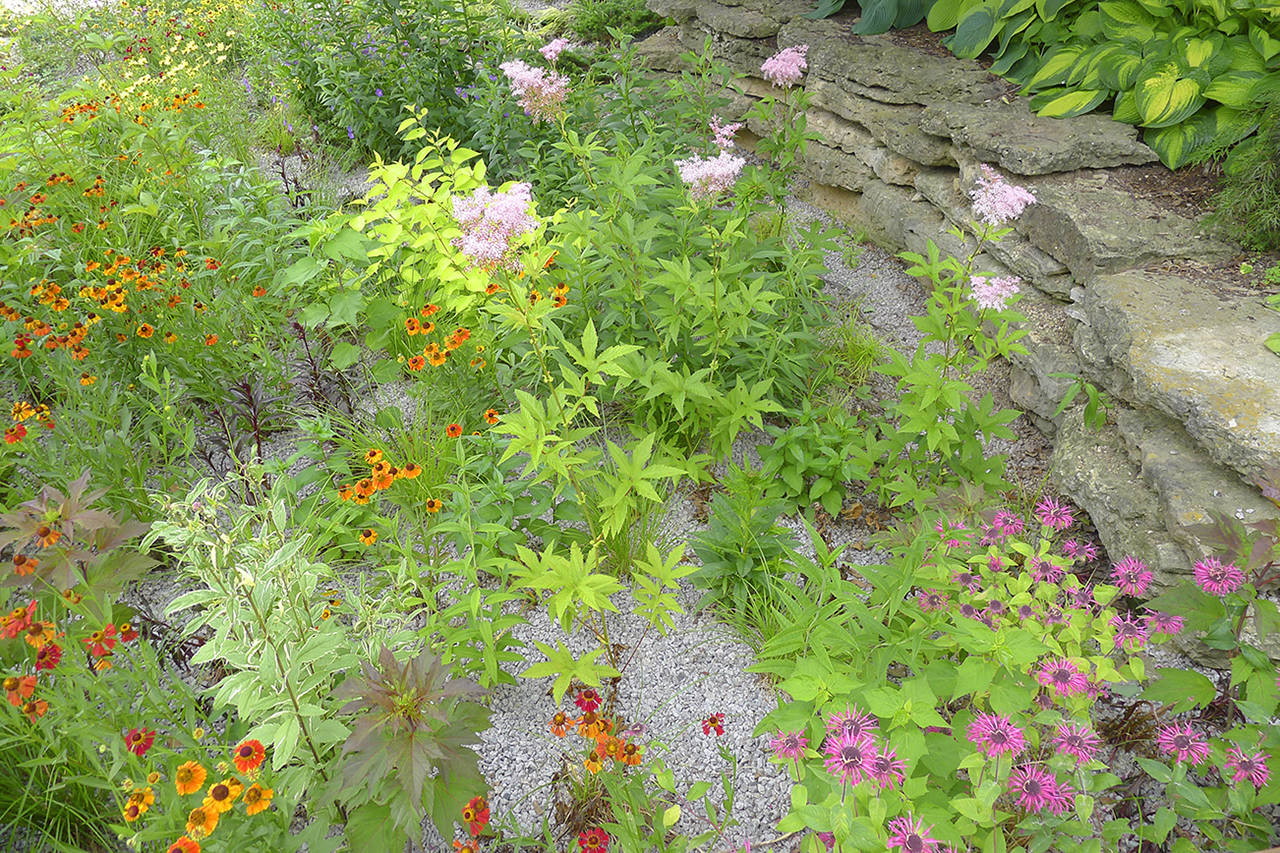By Kim Smith
WSU Master Gardener
As we head into the rainy season, maybe you’re starting to notice a river of water running off your driveway or a washout in the lawn where a gutter drains. These are perfect indications that a rain garden could be a beautiful and functional addition to your landscape.
A rain garden is an area designed to collect stormwater from your property to contain it and clean it as it filters through the soil and roots of selected plants. This mimics the way our well-established native vegetation and forests reduce runoff, erosion and pollution, while improving aesthetics, wildlife habitat and much more.
A rain garden is not a pond, but rather a shallow garden bed that has the capacity to hold water for a short time as it absorbs into the earth.
Home landscapes often include impermeable surfaces, such as rooftops, patios, walkways and driveways. These are areas where water is not able to infiltrate and can contribute to greater regional problems, such as water pollution and flooding. Installing your own rain garden can be a beautiful addition to your yard, while helping to alleviate these problems on your property, throughout your local community, and in the surrounding watershed.
To begin planning your rain garden, look at possible sites where runoff normally occurs or places where stormwater could be channeled. There are a few limitations; some places to avoid include areas near building foundations, steep slopes, utility lines and septic tanks.
Because the purpose of a rain garden is to absorb and filter the water through the soil, the soil should be tested for texture and percolation rate to determine that it drains well. In addition, if an area already has standing water or high groundwater during the winter, that would not be a suitable site for a rain garden.
Once an appropriate site has been found, you can design and build a rain garden as big or as small as needed and tailor the plants to fit into your overall garden design. The construction of a rain garden entails digging out the desired area 2 to 3 feet feet deep and installing the inflow and establishing the overflow. Stormwater can be channeled into the garden by a swale or a pipe. At the other end, line the overflow with rocks to direct the excess water away into a smaller rain garden or open space (away from buildings or neighboring properties). The excavated area is then refilled partway with a well-draining soil mix, leaving 6 to 12 inches of ponding depth where stormwater can accumulate and be held as it percolates into the earth.
The unique climate of the Pacific Northwest means the plants for the rain garden must be both water- and drought-tolerant. Thankfully, native species are adapted to this climate.
Place water lovers such as rushes, sedges, iris, red-twig dogwood and twinberry in the center of the garden (Zone 1 in the graphic). Daylilies, camas, columbine, boxwood honeysuckle and dwarf Oregon grape can add color and texture to the next layer (Zone 2) in the intermediate area between the deep center and outer berms. The plants toward the outer edges (Zone 3) should be the most drought‑tolerant, such as evergreen huckleberry, red-flowering currant, snowberry and various ornamental grasses.
Directly after planting, be sure to cover the bare ground with a mulch, such as wood chips to retain soil moisture, reduce weed pressure and prevent erosion.
In the first two years, it is important to keep the young plants well-watered and the weed pressure low; but once well-established, this garden will be relatively care-free. Just remember to keep the inlets and overflows clear and reapply mulch as necessary.
The layers of lush vegetation in this rain garden will provide wildlife habitat and stunning year-round displays of flowers and unique foliage, all while capturing and cleaning the stormwater.
For more detailed instructions and tips, explore ext100.wsu.edu/raingarden for an excellent demonstration video, a downloadable version of Rain Garden Handbook for Western Washington, and more.
Kim Smith, who lives in Porter, joined the WSU Master Gardener Program in 2016.
* * *
Join the WSU Master Gardener Program! A new class begins in January. Email 2018mgtrainees@gmail.com for more information.



